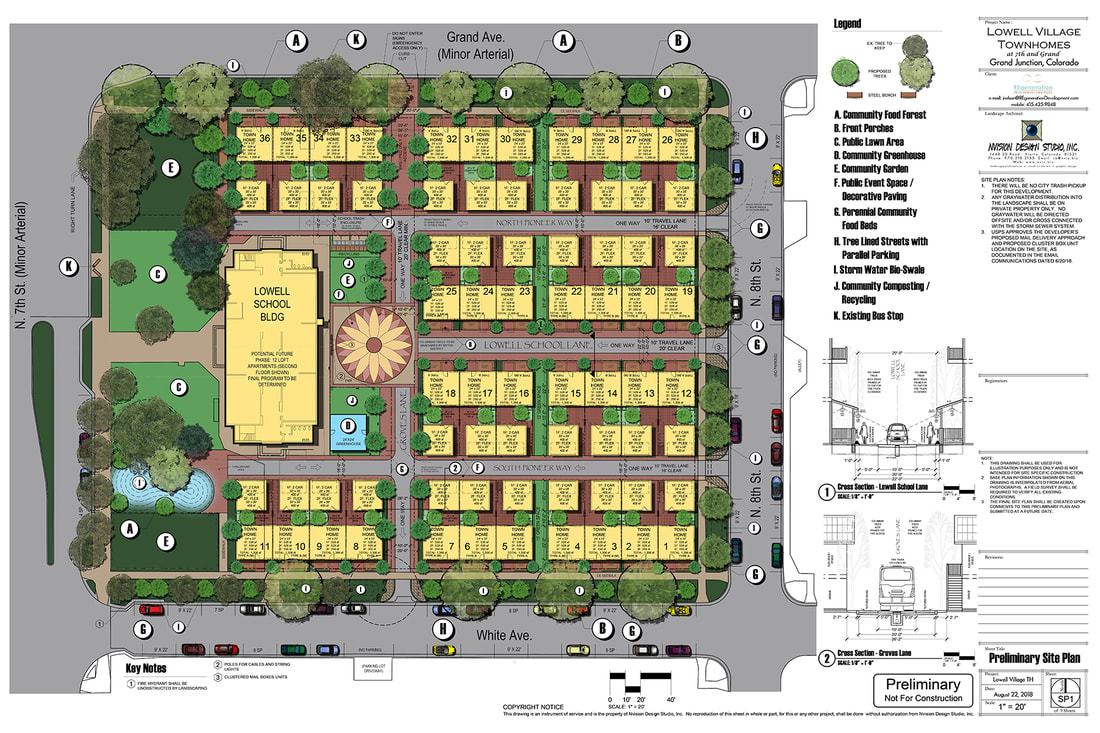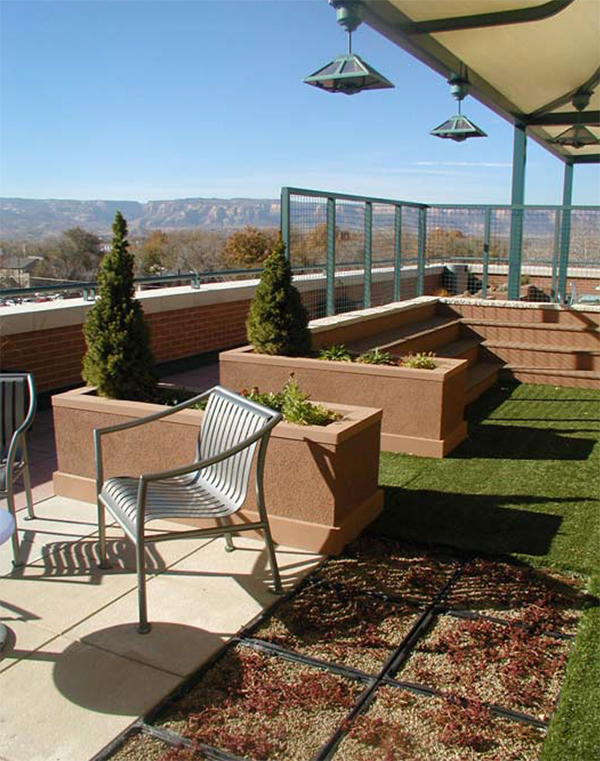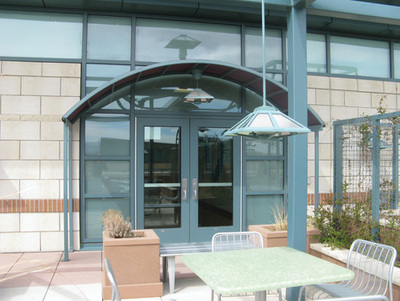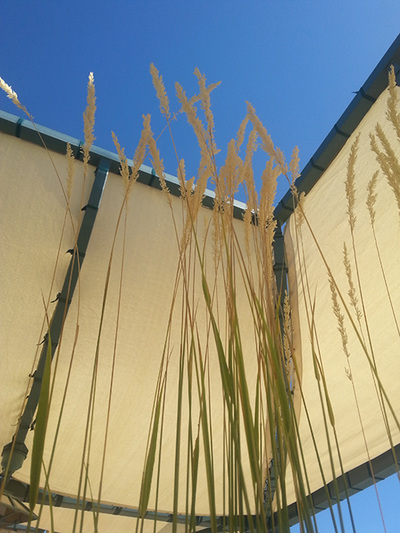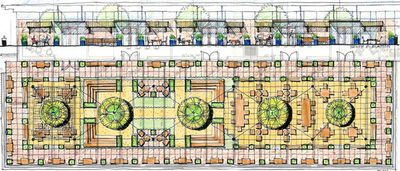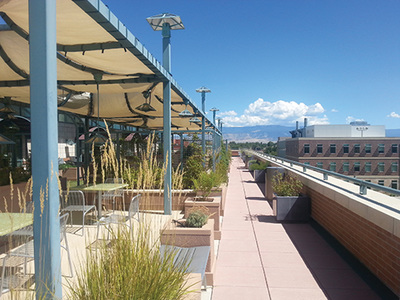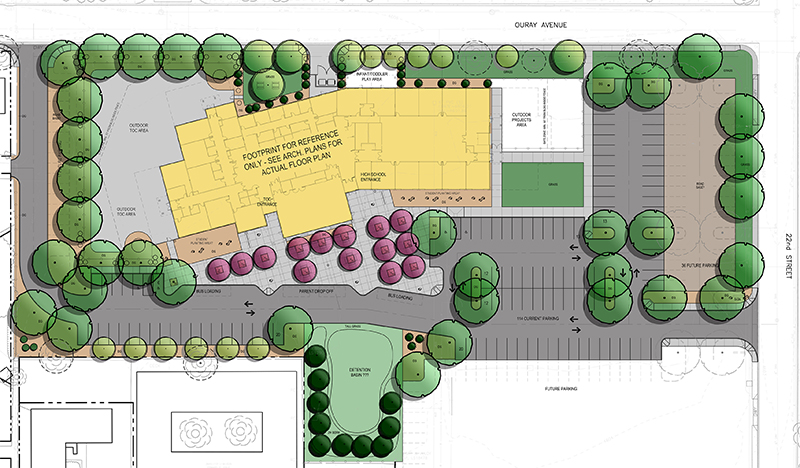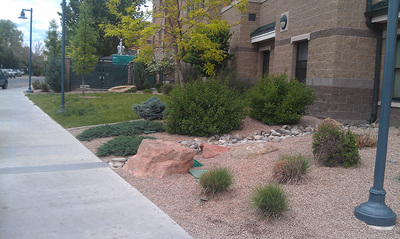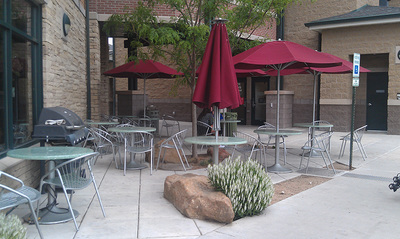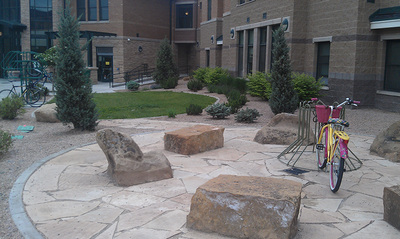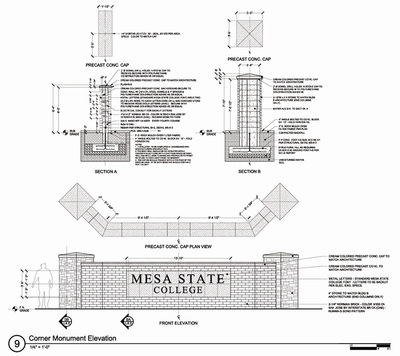Marillac Clinic Grand Junction, CO
Grand Junction High School Grand Junction, CO
The Junction Apartments Grand Junction, CO
Grand Valley Catholic Outreach Grand Junction, CO
Camelback Gardens Grand Junction, CO
Camelback Gardens is a proposed 10-acre residential development complete with multi-story attached townhomes, detached residential homes, private trails with connections to adjacent open space, two public neighborhood parks, and a community garden. The development will utilize a number of shared private drives with small lots/building envelopes and significant amounts of improved and maintained private open space. The open space will provide for better utilization of infrastructure and increased recreational opportunities within the Redlands area. Nvision Design Studio, Inc. was hired to assist in the creation of a community concept and the resulting overall development plan and site plan. As of early 2025, the project is in the planning stages at the City of Grand Junction Community Development Department.
El Jets Cantina Grand Junction, CO
Sky Outpost and El Jet’s Cantina consists of an 81-unit camping park, restaurant/cantina, community building, casitas, and large outdoor seating and recreation area located with the Dos Rios Development near Downtown Grand Junction adjacent to the Colorado River. Sky Outpost is a Baja-inspired glamping/camping/lodging with unique pods including ADA-accessible sites, custom renovated vintage caravans (think Airstreams, Spartans, Silver Streaks), surf shack casitas, NOMAD® cabins, Excursion van sites, and glamping tent sites. El Jet's Cantina is a Baja-inspired indoor/outdoor cantina + eatery and will host 4 food trucks. The site will also include a live music venue, hammocks, chimineas, firepits, swing shack, shade palapas, beach volleyball, and climbing walls. NVIZ has been involved from the beginning design phases of the project and has provided the Master Site and Landscape Planning and Construction Documents related to landscape and irrigation. The landscape will consist of drought tolerant plants with locally sourced tan granite rock mulch regionally appropriate for the Grand Junction desert landscape.
Watson Island Disc Golf Course Grand Junction, CO
The City of Grand Junction Parks and Recreation Department hired Nvision Design Studio, Inc. to map out areas for re-vegetation with overlays of the disc golf course at Watson Island in Grand Junction, Colorado. The scope of work included layout and recommendations for irrigation mainline routes and zoning. There were two locations available with 2" raw water taps, which the City will be utilizing to establish native landscapes, on a temporary basis and/or supplemental water source. The main goals were to define disc golf fairways; reestablish trees and other vegetation, define walkways and maintenance access, and locations for trash cans and benches. Most of the holes are defined, but the City is interested in scaling them back to a 27 hole course (boundaries greater than this scope of work) and limiting most holes to 3 pin placements or less. Guidance from the disc golf community is being provided to make recommendations on the layout and to define the skill level they want to commit to for this course. To this point it is very undefined. Nvision Design Studio, Inc. is responsible for the Landscape Architectural design and documentation for the project only. The landscape area related to this contract was 691,495 sf.
Dos Rios Splash Park Grand Junction, CO
The Riverfront at Dos Rios is a public-private partnership between the City of Grand Junction and private developer May-Riegler. The Riverfront at Dos Rios is a 58-acre mixed-use development in the heart of the City of Grand Junction near the confluence of the Gunnison and Colorado River. It consists of 16 acres of parks and open space, 10 acres of retail/commercial use and acres of mixed-use development, including residential. The City is nearing completion of a $10.9 million public investment in street and utility infrastructure. The proposed splash park contemplated with this request for proposal is a separate project. The Riverfront at Dos Rios is a significant development along the Colorado Riverfront. As such, the City desires a regionally iconic splash park to serve as key amenity not only to the development but the entire Colorado River corridor and region. This splash park project will enhance the Riverfront at Dos Rios development that will stimulate economic development. The splash park will serve the mixed-use development and provide a destination within the regional park, open space and recreational amenities along the Colorado River. A 23,000 square foot section next to the recently constructed public park amenities will be developed as a splash park as shown in the enclosed design to serve both artistic and recreational purposes.
Coloramo Credit Union Fruita Fruita, CO
This project is located on one of the busiest corners in downtown Fruita, Colorado. Nvision Design Studio, Inc. prepared several conceptual site and landscape plans for the project which will be converted into construction documents following City review.
The landscape plan elements include small public gathering areas, a bike repair station, flat topped boulders and steel benches along sidewalks for seating, micro-basins for concentrating on-site drainage, vertical vine-climbing screens to screen the parking lot, and a mixture of drought tolerant and low maintenance plants that provide year-round color and texture.
The landscape plan elements include small public gathering areas, a bike repair station, flat topped boulders and steel benches along sidewalks for seating, micro-basins for concentrating on-site drainage, vertical vine-climbing screens to screen the parking lot, and a mixture of drought tolerant and low maintenance plants that provide year-round color and texture.
Coloramo Credit Union GJ Grand Junction, CO
The majority of this commercial landscape will be removed and replaced with new materials using a new design theme. Most of the existing turf grass will remain undisturbed. The new design theme draws from the character of the regional landscape of western Colorado with its seasonal color and texture variations. The red rocks and evergreen trees of the Colorado monument, and the cobble edges along the Colorado river and its tributaries provide the thematic basis for this landscape design.
Evergreen shrubs and trees that provide winter color and screening combine with deciduous trees and shrubs that produce red fall-colored leaves and stems. A mixture of drought tolerant perennials will be mixed into the understory to provide flower color throughout the growing season.
Berms and boulders will be arranged around the perimeter of the property to provide vertical interest and character and to provide a buffer of the parking areas. Tan granite rock mulch will be used to provide a low maintenance ground cover on the berms and shrub beds and river cobble will be used in shallow swales to create the look of dry creeks. These swales will convey water away from the building. The design utilizes several species of ornamental grasses to lower maintenance, buffer the parking lot, and provide multi seasonal color and texture.
Two focal elements will be placed along sight lines for people waiting at the drive thru and ATM bays. These elements may be art pieces, inspirational signs, or sculptural boulders.
An important aspect of this project is to create a more comfortable environment for customers by providing shade between the parking lot and building entrances. A steel framed pergola with a fabric canopy will provide shade on the south and west sides of the building and office windows as well as the entrance sidewalks. The color of the steel frame will match the dark bronze color of the window frames and the fabric will resemble the color of the building. The layout of the pergolas well as the utility box screens mimic the square pattern of the windows and doors on the building tying together the existing building with the newly installed landscape features.
Evergreen shrubs and trees that provide winter color and screening combine with deciduous trees and shrubs that produce red fall-colored leaves and stems. A mixture of drought tolerant perennials will be mixed into the understory to provide flower color throughout the growing season.
Berms and boulders will be arranged around the perimeter of the property to provide vertical interest and character and to provide a buffer of the parking areas. Tan granite rock mulch will be used to provide a low maintenance ground cover on the berms and shrub beds and river cobble will be used in shallow swales to create the look of dry creeks. These swales will convey water away from the building. The design utilizes several species of ornamental grasses to lower maintenance, buffer the parking lot, and provide multi seasonal color and texture.
Two focal elements will be placed along sight lines for people waiting at the drive thru and ATM bays. These elements may be art pieces, inspirational signs, or sculptural boulders.
An important aspect of this project is to create a more comfortable environment for customers by providing shade between the parking lot and building entrances. A steel framed pergola with a fabric canopy will provide shade on the south and west sides of the building and office windows as well as the entrance sidewalks. The color of the steel frame will match the dark bronze color of the window frames and the fabric will resemble the color of the building. The layout of the pergolas well as the utility box screens mimic the square pattern of the windows and doors on the building tying together the existing building with the newly installed landscape features.
Velo Ridge Townhomes Grand Junction, CO
The landscape concept for this 9-unit town home project draws inspiration from the native desert combining evergreen shrubs and trees for winter color and screening with low maintenance shrubs and perennials providing seasonal color and texture. A community gathering area and bike repair station will be integrated into the entrance identification sign located under a large shade tree.
Berms and boulders will be arranged between the street and townhomes to provide vertical interest and buffering. Tan granite rock mulch will be used to provide a low maintenance ground cover on the berms and shrub beds and river cobble will be used in shallow swales to create the look of dry creeks. These swales will convey water away from the building. Boulder retaining walls on both the upper and lower property lines will be installed to provide easy garage and front door access to the units.
Berms and boulders will be arranged between the street and townhomes to provide vertical interest and buffering. Tan granite rock mulch will be used to provide a low maintenance ground cover on the berms and shrub beds and river cobble will be used in shallow swales to create the look of dry creeks. These swales will convey water away from the building. Boulder retaining walls on both the upper and lower property lines will be installed to provide easy garage and front door access to the units.
Nvision Design Studio was also hired to design the architecture for the townhomes. The client provided several photos of the exterior examples that were desired and floor plans and elevations were created. The architectural style is considered to be "southwest modern" with very clean lines and simple geometry. The exterior materials will combine cream colored stucco, tan and brown country ledgestone, dark bronze aluminum windows, doors, standing seam metal roofing, and contemporary style garage doors.
End units will include entry courtyards which can double as outdoor entertaining space and outdoor decks will provide second story views. The flat roofs will provide additional possibilities for outdoor space under shade canopies created by solar panels.
Each unit provides over 2000 sf of interior living area. The main floor Includes a 2 car garage with plenty of storage for bikes and and gear, a living room with storage area under the stairs, a small dining area, and a full kitchen with pantry. The second floor includes two bedrooms each with it's own bathroom and walk-in closet. A stack washer and dryer and utility closet will be close to each bedroom and the third room can be used as a bedroom or an office. Two of the three bedrooms have access to the second story cantilevered deck and the rooftop garden
End units will include entry courtyards which can double as outdoor entertaining space and outdoor decks will provide second story views. The flat roofs will provide additional possibilities for outdoor space under shade canopies created by solar panels.
Each unit provides over 2000 sf of interior living area. The main floor Includes a 2 car garage with plenty of storage for bikes and and gear, a living room with storage area under the stairs, a small dining area, and a full kitchen with pantry. The second floor includes two bedrooms each with it's own bathroom and walk-in closet. A stack washer and dryer and utility closet will be close to each bedroom and the third room can be used as a bedroom or an office. Two of the three bedrooms have access to the second story cantilevered deck and the rooftop garden
Lowell Village Townhomes Grand Junction, CO
This proposed development project for a 2-acre in downtown Grand Junction will bring new urban living options to the downtown area that currently do not exist. To our knowledge, there has been little to no ground-up, market-rate residential development in downtown Grand Junction in the past 20-30 years. Our proposed site/subdivision plan for this site will deliver 36 for-sale townhomes (30 with home offices/guest rooms), rehabilitate the Lowell School building as 12 for-rent loft apartments, and create new community gardens and greenspace. Having additional residents living and working at this site, coupled with putting the site back on the tax rolls, will help further the ongoing revitalization of downtown. Key elements of this innovative site and landscape plan include: micro-basins in public right-of-way spaces to capture urban runoff, food forest plants that provide perennial food production (such as fruit, nuts, berries, and herbs), community garden plots, a composting and recycling hub for residents, an on-site greenhouse to grow starter plants for the landscape areas, water harvesting using rain barrels, a gray water system, supplemental photovoltaic electricity generation for net metering, and accessory dwelling units above garages to address the ever-increasing affordable housing problem.
Colorado Mesa University Rooftop Garden Grand Junction, CO
|
This extraordinary project is one of the most unique in Western Colorado. Located at the Business College building three stories above the Mesa State College campus, this rooftop garden reveals extraordinary views of the Colorado National Monument, the Grand Mesa, and downtown Grand Junction. The project area measures 40 feet x 150 feet in size (6,000 square feet) and is located on the sunny south facing façade of the third floor of the building.
Initially, the design of this area was confined to a 25 foot x 52 foot space to be filled with “Green Grid®”, a modular roof tray system planted with Sedum plants. What evolved through the design process was one of three concepts developed for the rooftop, each with the thought of expanding the use of the building and providing a space in which the students and faculty could enjoy year-round. Early in its conception this space was intended to be engaged; where extraordinary views could be enjoyed; where conversations could be had; where studying was to be inspirational rather than mundane. The space consists of three outdoor rooms with benches, chairs and stair seating surrounded by a three-sided perimeter viewing area. Custom built, drip irrigated planters, have been used in concert with an ivy-covered “green wall” to create a wind buffer for the terrace. Craftsman style lighting is integrated into a custom designed and built shade canopy made out of bent steel tubing and cream colored shade fabric that provides relief from the hot summer sun. The flooring of the garden consists of three different colors of concrete pavers which rest on adjustable pedestals, synthetic turf, and Green Grid® planting trays. All of these elements combine to form the first public rooftop garden in Western Colorado that increases aesthetic value, increases roof life, increases insulation and energy efficiency, increases biodiversity and wildlife, manages water efficiently, reduces air pollution, reduces urban heat and noise pollution, and increases fire prevention. |
Bella Dimora Subdivision Grand Junction, CO
This project consisted of a 108-unit residential subdivision located on a 13.85 acre site on the south side of Patterson Road between 28 ¼ Rd and 29 Road in Grand Junction, Colorado. Nvision Design Studio, Inc. prepared the design and planning documents for the landscape areas located between the residential units, the property lines, and the hardscape areas on site.
The landscape concept for Bella Dimora is based on concentrating the majority of the planting along the main streets and in front of the residential units. The purpose for this treatment is to increase the visual appeal from the street looking into the units as well as to provide an attractive, beautiful, and low-maintenance landscape adjacent to each residence. The plant palette will be based mainly on native and adapted plants found in and around the Grand Valley and commonly sold at local nurseries.
This landscape treatment meets or exceeds the minimum requirements found in Chapter 21.06.040-Development Standards for Landscape, Buffering and Screening, and provides an enhanced aesthetic appeal as intended by the City of Grand Junction. The landscaping in this concept reduces heat and glare on the street and buildings, facilitates movement of traffic, shades cars and parking surfaces reducing local and ambient temperatures, buffers and screens cars from adjacent properties, promotes natural percolation of surface waters, improves air quality, buffers and screens potentially incompatible uses from one another, and conserves the value of property and neighborhoods within the City.
The landscape concept for Bella Dimora is based on concentrating the majority of the planting along the main streets and in front of the residential units. The purpose for this treatment is to increase the visual appeal from the street looking into the units as well as to provide an attractive, beautiful, and low-maintenance landscape adjacent to each residence. The plant palette will be based mainly on native and adapted plants found in and around the Grand Valley and commonly sold at local nurseries.
This landscape treatment meets or exceeds the minimum requirements found in Chapter 21.06.040-Development Standards for Landscape, Buffering and Screening, and provides an enhanced aesthetic appeal as intended by the City of Grand Junction. The landscaping in this concept reduces heat and glare on the street and buildings, facilitates movement of traffic, shades cars and parking surfaces reducing local and ambient temperatures, buffers and screens cars from adjacent properties, promotes natural percolation of surface waters, improves air quality, buffers and screens potentially incompatible uses from one another, and conserves the value of property and neighborhoods within the City.
BLM Regional Office Complex Grand Junction, CO
|
This project included the design and documentation for the landscape and related parking lot and streetscape of an office complex located on 6.2 acres of land in Grand Junction, Colorado.
In keeping with the requirements specified by the City of Grand Junction Development Code, the planting requirements for the project included 109 trees, 634 shrubs, 135 perennials, over 22,000 sf of irrigated native grass, and over 10,000 sf of turf grass. The seven principles for xeriscape landscape design were utilized in developing the planting design for the site: Planning & Design, Turf Alternatives, Mulches, Zoning of Plants, Soil Improvements, Efficient Irrigation, and Appropriate Maintenance. Following the LEED certification process, the general planting scheme was to provide turf areas to assist in cooling certain areas of the site near the building, as well as to provide breakout areas for the employees. In all other areas of the site the focus was to create attractive wildlife habitat and to provide shade for the parking lot and street, thus helping to reduce the urban heat island effect. As a Federal government requirement, the client required that the landscaping nearest to the street be arranged in such a way as to create a deterrent to errant or “hostile” vehicles that could potentially threaten the safety of the employees. This was done with the use of large boulders, trees, and shrubs located between the street/parking lot and the main building. |
Mesa County Valley School District 51–Alternative High School Grand Junction, CO
This project included the design and documentation for the landscape and related parking lot for an alternative school located on approximately 3 acres of land in downtown Grand Junction, Colorado. The desires from the school district team revolved around ease of maintenance, a theme that is very common in our current society. As budgets in the public school system continue to get slashed, so then do program elements. We took it as a challenge to find creative and cost effective ways to achieve design goals for this project.
The landscape program included large shade trees to help reduce the urban heat island effect, simple decomposed ground cover areas to minimize maintenance, a multi-use entrance plaza for students and faculty, and three outdoor explorative spaces designed for experiential learning, teaching, and recreation. Some innovative programs that were discussed throughout the project included the involvement of the students in the development of the site, such as tree and flower planting, fence building, and raising food in outdoor hoop houses and raised planters.
The landscape program included large shade trees to help reduce the urban heat island effect, simple decomposed ground cover areas to minimize maintenance, a multi-use entrance plaza for students and faculty, and three outdoor explorative spaces designed for experiential learning, teaching, and recreation. Some innovative programs that were discussed throughout the project included the involvement of the students in the development of the site, such as tree and flower planting, fence building, and raising food in outdoor hoop houses and raised planters.
Colorado Mesa University Residence Hall Grand Junction, CO
This project included the design and planning for the landscape located at the corner of North Avenue and Cannell Avenue located on the Colorado Mesa University (prev. Mesa State College) campus in Grand Junction, Colorado. The project included the future demolition of two commercial buildings and three residential buildings and the construction of three new buildings, a parking lot and drive aisle, pedestrian paving and a plaza, and an open play field.
This scope of work included the design and documentation of all landscape areas consisting of approximately 58,625 square feet. The design included conceptual and schematic grading and layout of pedestrian paving, site lighting, signage, site furniture, planting, and irrigation. Nvision Design Studio, Inc.. worked closely with the Architects in order to achieve consistency and unity between the site components and the architecture.
This scope of work included the design and documentation of all landscape areas consisting of approximately 58,625 square feet. The design included conceptual and schematic grading and layout of pedestrian paving, site lighting, signage, site furniture, planting, and irrigation. Nvision Design Studio, Inc.. worked closely with the Architects in order to achieve consistency and unity between the site components and the architecture.
Rifle Creekside Subdivision Rifle, CO |
Landscape Plan |
|
This project included the preparation of landscape architectural drawings and design related services for the proposed Rifle Creek Subdivision located at the intersection of Acacia Drive and Creekside Drive in Rifle, Colorado. The project is within the jurisdiction of the City of Rifle.
The design theme integrated Xeriscape™ landscape principles and followed all of the guidelines set forth in Chapter 16, Article XIII of the Rifle Land Use Code. The landscape design included a combination of trees, shrubs, perennials, and turf grasses, as well as natural nonliving elements such as rock mulch and native landscape boulders. The submittal requirements to the City of Rifle included Landscape plans requiring the following items: calculation of net site area, calculation of required landscape treatment area, location and dimensions of areas to be landscaped and areas of existing landscaping, location, general type and quality of existing vegetation, existing vegetation to be saved, locations and labels for all proposed plants, plant schedule with the botanical and common names, quantity, spacing and size of all proposed landscape materials at the time of planting, location and description of other landscape improvements such as earth berms, walls, fences, screens, sculptures, fountains, street furniture, lights and courts or paved areas, location and coverage of required irrigation systems, planting and installation details as necessary to ensure conformance with all required standards, and a guarantee from the developer that all plant materials will be warranted for a period of twenty-four (24) months from the time of installation. |
DeBeque Farms DeBeque, CO |
Landscape Plan & Photo Simulation |






























































